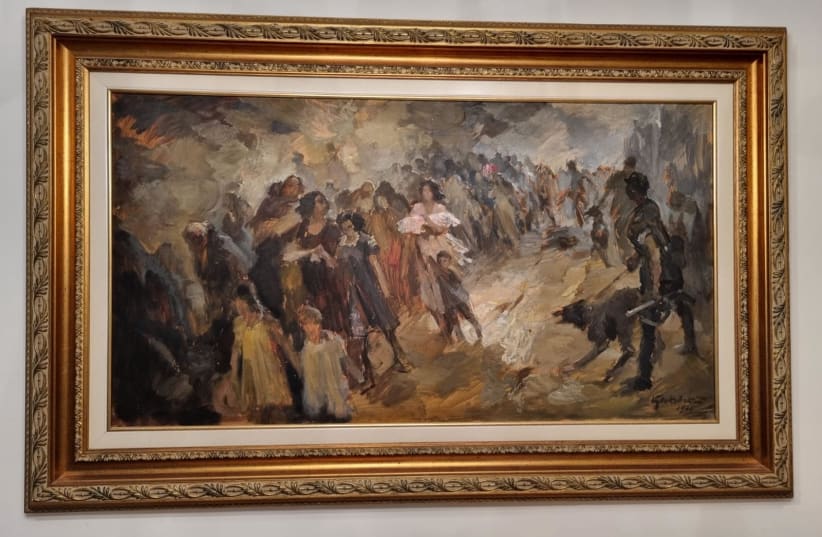The rich heritage and the enduring pain of the Jewish people across generations have inspired numerous works of art. Among them, the most impactful and renowned is the painting 'The Last Way', depicting the tragic murder of approximately 33,000 Jews at Babi Yar. While this powerful artwork has decorated the Israeli Parliament for many years, it has recently come to light that there exists an original version of the painting, now held in private hands
In just two harrowing days, from September 29th to 30th, 1941, one of the most tragic events in history unfolded. Approximately 33,000 Jews fell victim to the Nazis and their local collaborators at Babi Yar, marking the annihilation of a significant portion of Kyiv's Jewish community in Ukraine.
For years, attempts were made to obscure the events at Babi Yar, but some individuals were determined to bring the truth to light. Among them was the artist Yosef Kuzkovsky, whose own family perished in the massacre. Kuzkovsky created a poignant and moving work of art, capturing a profound moment. The painting portrays a Jewish mother holding her young daughter's hand in one grip while cradling her baby to her chest with the other, just moments before they face execution by gunfire.
Kuzkovsky completed this original masterpiece, which was recently discovered in 1946 and undertook a daring feat by smuggling it to Israel when he immigrated from the Soviet Union in 1971. This endeavor was no small feat, as recounted by a close friend (whose identity remains confidential): “Yosef and I were part of the same Jewish youth movement in Riga, the present-day capital of Latvia, which was then part of the Soviet Union. A significant aspect of our social activities revolved around Jewish tradition and discussions about the State of Israel. Engaging in any activity not sanctioned by Soviet authorities could result in imprisonment, but we continued despite everything. In 1967, discussions arose within the local community about the prospect of immigrating to Israel. For this, we embarked on a prolonged struggle that included personal appeals to prime ministers and presidents around the world. We were all very excited when the idea matured into action, and those who first immigrated to Israel were couples without children, like Yosef and his wife.
Yosef, an exceptional artist, possessed numerous paintings, but bringing them into the country required special permission. During that era, items of significant value were prohibited from leaving the Soviet Union. Despite these challenges, I employed indirect methods to sway the deputy director of the central museum in Riga. This influence allowed us to include Yosef's paintings in a sizable container that eventually found its way to Israel".
One of Yosef Kuzkovsky's remarkable paintings, was the version he painted in 1948 of 'The Last Way', found its way to the Knesset after being purchased from Yosef's widow in 1971.
Since then, the painting has adorned a prominent wall, becoming a focal point for Knesset tours attended by politicians from across the globe, as well as organized tours for the general public. The significance of the painting extends to its inclusion in the curriculum of educational institutions throughout the country. In the 1980s, Israel Post even honored the artwork by issuing a stamp featuring its portrait.
However, the plot thickens, and the story continues to unfold. A few weeks ago, we featured an article highlighting the five greatest and most revered Jewish artworks globally, with one of them being 'The Last Way'.
In a surprising twist, we discovered that just before Yosef Kuzkovsky immigrated to Israel, he entrusted the original painting which was painted in 1946 'The Last Way' to his close friend.
"As close friends, my wife and I played an instrumental role in assisting Yosef Kuzkovsky with all the preparations for his immigration to Israel. I also made significant contributions to ensure that all his paintings obtained permission to leave the Soviet Union through indirect means. Just before we bid farewell, he entrusted me with the original painting he created in 1946".
There are notable distinctions between the original painting and the one exhibited in the Knesset, primarily in size, with the original being smaller. Additionally, differences exist in terms of color elements. Although both paintings are mainly in black and white, the original is slightly darker. This divergence can be attributed to the period in which the painting was executed—shortly after the Holocaust, during a time when Yosef Kuzkovsky grappled with profound pain over the loss of his family members. The version in the Knesset features brighter elements, reflecting the optimism that embraced Yosef with the establishment of the State of Israel.
As of today, the original painting of 'The Last Way' is in private hands, residing with a collector in Florida, US.
This article was written in cooperation with The Jewish Culture Art
